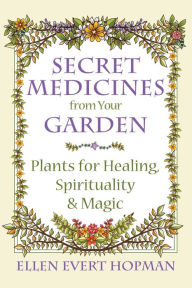I’ve been practicing herbalism for more than 20 years and I’m pretty picky about herbalism books. For me, this one stands out in a very positive way. It’s both deeper and wider than the usual encyclopedia-style herbal. Hopman leads the reader through the process of getting to know the herbs personally, almost intimately, and includes information I haven’t seen elsewhere. Sometimes when I’m reading a book for review it feels like work, even if it’s a good book, but this one was just a delight the whole way through. It’s crammed full of information and I could really feel the author’s love for the Green People coming through on every page. This book feels less like an instruction manual and more like someone introducing me to all her friends.
The book is divided into four parts. Part One: A Wildcrafting Primer takes the reader through wildcrafting by season rather than via the usual alphabetical listing. I’m really pleased with this. A seasonal arrangement is the smartest way to organize herbs that will be foraged or picked in the yard and garden. This section includes not just seasonal plant information but also some great information about the Doctrine of Signatures, which is a way to help understand an herb’s uses based on its physical characteristics.
Part Two: Exploring Invisible Dimensions of the Plant World explores some of the more spiritual aspects of herbalism. Hopman provides a separate chapter for Dracaena and Mullein, two plants that are obviously special to her. Dracaena is the endangered tree whose resin is the ever-popular Dragon’s Blood. One very nifty bit from this section is the author’s instructions for how to make a working torch from the bloom stalk of the mullein plant. I’ve always called the bloom stalks ‘mullein torches’ but now I know how to make a mullein torch that will actually burn and provide light!
Part Two also includes chapters on animal spirit medicines, herbal astrology and how to work with the plant spirits. Hopman’s animal spirit practices are based on Native American concepts, largely from the region in the northeastern U.S. where she lives. This is a fascinating set of information that groups plants with particular animals spirits (bear, elk, badger, and so on) based on the plants’ overall energy and purpose. This provides a deeper meaning for these herbs, a different point of view about the medicine they can offer us. Just a note: Many of the plants in this section are native to North America and can’t be found elsewhere. But most of the herbs in the rest of the book are common throughout the northern temperate zone.
The chapter on herbal astrology and plant alchemy associates plants with the planets and zodiac signs, which is a really interesting practice that goes back centuries. I especially enjoyed the chapter on plant spirits. I think it’s important to have a relationship with the plants and not just use them as if they were bottles of pills on a shelf. Hopman offers some lovely ways to show your appreciation to the plant spirits, including singing and offering them prayers and blessings.
Part Three: Enjoying Nature’s Bounty once again serves up plenty of useful information, including some things you won’t find in most herbals. There’s a whole chapter on Bee Medicine, which is so important now that the bees are in danger from human practices such as certain pesticides. This chapter includes the history of magical and practical uses of bees, honey and beeswax as well as all kinds of interesting bee lore and both medicinal and culinary recipes.
Part Three also includes a chapter on kitchen medicine: helpful uses for the herbs and spices you can find at your local supermarket. This part also includes some subjects I’ve rarely seen in herbals: instructions for how to plant and grow a hedgerow as well as all sorts of information about both deciduous and coniferous trees. I was fascinated by the chapters about the trees, especially all the recipes for food, medicine, and incense from the leaves, bark, resin, and other ‘tree parts.’
The final section is Part Four: Formula Making, and just this section alone is worth the price of the book. In addition to all the usual instructions for how to make herbal teas, tinctures, poultice, and so on, Hopman includes a large compendium of information based on her teacher William LeSassier’s method of constitutional prescribing. This technique arranges herbs by hot/cold/wet/dry characteristics and applies them based on this system to many common health conditions. Many years ago, I learned the hot/cold/wet/dry correspondences (which go back at least as far as the Middle Ages) when using herbs for magical purposes, but I’ve never seen the system organized so thoroughly and with such detail for medicinal and health uses.
The book finishes with several helpful appendices. There’s an excellent section on herbal contraindications, which is very important because so many people seem to think that natural automatically means safe. The Sources and Resources section is extensive and is organized by chapter. The book finishes with three indexes: plants by common name, plants by scientific name and a list of common health concerns.
The whole tone of Secret Medicines is friendly and informative, obviously written by someone who cares deeply about the plants and about making sure the knowledge of how to use and respect them is not lost. This one is already one of my favorite herbal references, and I’m sure it will continue to maintain a place of honor on my shelves.
~review by Laura Perry
Author: Ellen Evert Hopman
Healing Arts Press, 2016
pp. 337, $19.95
Secret Medicines from Your Garden: Plants for Healing, Spirituality and Magic

©
2010 - 2025
Facing North
